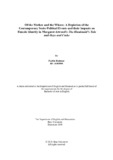| dc.contributor.advisor | Saba, Anika | |
| dc.contributor.advisor | Khair, Masnoon | |
| dc.contributor.author | Rahman, Farhin | |
| dc.date.accessioned | 2020-08-06T04:55:51Z | |
| dc.date.available | 2020-08-06T04:55:51Z | |
| dc.date.copyright | 2019 | |
| dc.date.issued | 2019-12 | |
| dc.identifier.other | ID 16303004 | |
| dc.identifier.uri | http://hdl.handle.net/10361/13902 | |
| dc.description | This thesis is submitted in partial fulfillment of the requirements for the degree of Bachelor of Arts in English, 2019. | en_US |
| dc.description | Cataloged from PDF version of thesis. | |
| dc.description | Includes bibliographical references (pages 49-52). | |
| dc.description.abstract | This thesis aims to outline the contemporary global socio-political events (those of the twentieth and twenty-first century), with special focus on the rise of fundamentalist politics and technological advancements to highlight how women are targeted and used for the agendas of the patriarchy in the real world and their reflection in the dystopian realities of Margaret Atwood’s The Handmaid’s Tale and Oryx and Crake. The purpose is to show that these dystopian worlds are in fact depictions of the real world and stand as both a historical force and prophetic warning of what is to come if our present habits persist. Of the many aspects, this thesis particularly examines the role of patriarchal supremacy, fundamentalist politics and the growing consumerist culture in oppressing women through methods of politicising and sexualising their existence. The oppression of women is analysed in the ways motherhood is casted on to them, and the many other ways their bodies are objectified and commoditised, resulting in women being labelled with identities as decided by men. Simone de Beauvoir and Edward Said’s concepts of “othering” have been substantial to the examination carried out in this paper, along with Adrienne Rich and Kathleen Gough’s frameworks characterising male dominance which have given this paper an anthropological insight into how male power over females is projected. Therefore, this thesis shows how the twentieth and twenty-first century real world events have been depicted in the novels, focusing on patriarchy and its various roles in shaping women’s identities by institutionalising motherhood, reproductive colonisation and sexualising or politicising their bodies to label them as either mothers, or the unwomen/prostitutes. | en_US |
| dc.description.statementofresponsibility | Farhin Rahman | |
| dc.format.extent | 52 pages | |
| dc.language.iso | en | en_US |
| dc.publisher | Brac University | en_US |
| dc.rights | Brac University theses are protected by copyright. They may be viewed from this source for any purpose, but reproduction or distribution in any format is prohibited without written permission. | |
| dc.subject | Television series | en_US |
| dc.subject | Oryx and Crake | en_US |
| dc.subject | Reproductive rights | |
| dc.subject | Religious fundamentalism | |
| dc.subject | Female identity | |
| dc.subject | Politics | |
| dc.subject | Motherhood | |
| dc.subject | Child trafficking | |
| dc.subject | Margaret Thatcher | |
| dc.subject | Margaret Atwood | |
| dc.subject | The Handmaid's Tale | |
| dc.title | Of the Mother and the Whore: a depiction of the contemporary socio-political events and their impacts on female identity in Margaret Atwood’s The Handmaid’s Tale and Oryx and Crake | en_US |
| dc.type | Thesis | en_US |
| dc.contributor.department | Department of English and Humanities, Brac University | |
| dc.description.degree | B.A. in English | |

